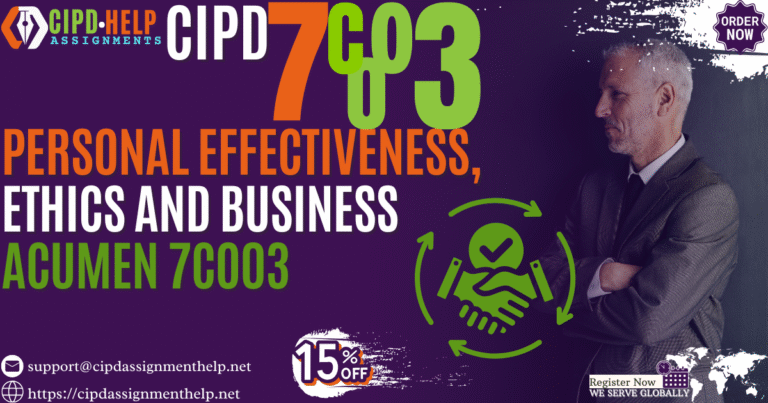7CO02 People Management and Development Strategies for Performance Assignment Example Outline
Task 1: Understand the benefits of aligning people practices with organisational strategy and culture.
Explain the major objectives of people practice and the ways of achieving these may benefit employers and employees.
- Major objectives of people practice
- Attract and retain competent staff
- Effective resourcing and development
- Efficient implementation of people policies
- Ways of achieving these objectives
- Diversity and inclusion initiatives
- Learning and development to retain talent
- Employee engagement for creativity, commitment and productivity
- How the ways of achieving objectives of people practice may benefit employers and employees?
- Employers
- Enhanced decision-making
- Achieve/gain higher profits
- Attract and retain top talent
- Employees
- Learning opportunities
- Innovation and creativity
- Employee job satisfaction
- Employers
- The implications of these objectives and ways of achieving them to people practice professionals in organisations.
Explain the advantages associated with aligning people management policies with organisational strategy and risk.
- What are people management policies
- What does it entail by aligning people management policies with organisational strategy and risk?
- It involves integration of human resources (HR) planning and activities into the organization’s strategic plan
- Forecasting labour demand and supply
- Monitoring external trends
- Partnering with business leaders
- Business ensures to stay ahead of the curve
- It involves integration of human resources (HR) planning and activities into the organization’s strategic plan
- Advantages associated with aligning people management policies with organisational strategy and risk
- Enhanced employee performance
- Management of risk in the organisation
- Making of well-informed decisions
- What happens if people management policies are not aligned with organisational strategy and risk? That can lead to negative effects such as;
- Inefficiencies
- Increased costs
- Decreased employee morale
Evaluate ways in which organisations integrate people management practice within their culture, brand and values.
- What does it entail in people management practice?
- Recruitment
- Reward management
- Staff management
- Employee resourcing
- Ways in which organisations integrate people management practice within their culture, brand and values?
- Role modelling
- Employee empowerment
- Training and development
- Inclusion
- Reflecting values, culture, and brand in company’s policies and practices
- To what extend are these ways effective in promoting greater results for the organisation?
- What are the negative effects of organisations not integrating people management practice within their culture, brand and values?
Critically evaluate models of systemic thinking and how they underpin the inter-connective nature of people practice work.
- What is systemic thinking?
- Models of systemic thinking
- The Iceberg model
- Observable drivers of systemic issues
- Events
- Patterns
- Hidden drivers of systemic issues
- Systemic structures
- Underlying forces/mental models
- Senge’s five disciplines
- Personal mastery
- Mental models
- Shared vision
- Team learning
- Observable drivers of systemic issues
- The Iceberg model
- Critical evaluation:
- Strengths and weaknesses of the models
- Which model best defines or describes the purpose of systemic thinking?
- How these models underpin the inter-connective nature of people practice work
- The iceberg model
- Identifying events causing change and understanding the symptoms
- People practice understand the patterns, anticipate and get ahead of issues instead of reacting
- Learn behavioural patterns between components in the organisation and the conditions shaping these patterns
- People practice can identify the needed shifts to bring substantive and sustainable change
- Senge’s five disciplines
- Promoting organisational learning
- Each system build skills necessary for people practice to effectively analyse complexity and catalyse change
- People practice can recognise interdependencies and change of behaviour cause by the system structures
- The iceberg model
Task 2: Understand how the development of people practices improved organisational performance and employee experience.
Examine the merits of different models of people practice management, linking them with effective business performance
- Give a brief description of the models of people practice management
- Different models of people practice management
- Harvard model
- Warwick model
- The ASTD Competency model
- The Ulrich model
- The 5 Ps model
- The merits of different models of people practice management
- They offer different perspectives for consideration when structuring the role and value of people practices for efficiency and increased productivity
- They increase people practice professionals acuity as strategic players in management of human resources for improved business performance
- Gives effective decision-making point based on unique needs and goals of a workforce in the organisation for greater performance
- Counterargument – What if there are no models of people practice management? What are the negative impacts on business performance?
Critically evaluate research that links people management practice in organisations with improved employer outcomes.
- What are employer outcomes?
- Research that links people management practice in organisations with improved employer outcomes.
- Well-established Human Resource Management policies and regulations
- Training and development
- Effective leadership and management practices
- Manager actions and attitudes
- Evaluation
- To what extend is the research effective in clarifying people management practices with an impact on employer outcomes?
- Do the various research subjects agree on employer performance outcomes enhancing people management practices?
- What are the similarities and differences of the researches
Critically evaluate best practice, contingency and resource-based approaches to the development of people management practices.
- Best practices
- What are best practices?
- Best practice approaches to the development of people management practices
- Clear communication with employees
- Adoption of flexible working programs and policies
- Employee development and training
- Reward management
- Contingency approaches
- What are contingency approaches?
- Contingency approaches to the development of people management practices
- Situational leadership
- Decision-making theory
- Path-goal theory
- Resource-based approaches
- What are resource-based approaches?
- Resource-based approaches to the development of people management practices
- Strategic human resource management
- Project resource management
- Enterprise resource management
- Critical evaluation
- Strengths and weaknesses of these approaches?
- Which approach best describes effective development of people management practices?
Explain how high-performance work practices are associated with positive organisational and employee outcomes.
- Give a brief description of high-performance work practices. For example
- Comprehensive hiring procedures
- Participatory decision-making
- Extensive training
- Flexible job design
- How do high-performance work practices associate with positive organisational and employee outcomes?
- Positive organisational outcomes
- Achievement of competitive advantage in the marketplace
- Better financial performance
- Improved social organisational structure
- Positive employee outcomes
- Reduced employee turnover
- Increased innovation
- iii. Increased employee productivity
- Positive organisational outcomes
- What are the implications for people practice professionals in the organisation?
Task 3: Understand current practice in major areas of people management and development work.
Discuss major areas of responsibility in people management work in organisations.
- Major areas of responsibility in people management work in organisations.
- Recruitment – for example; find, hire and welcome new team members
- Training and development – for example; guide staff and support workers’ growth
- Employee management – employee appraisal
- Problem-solving – resolving conflicts and disagreements among staff
- Building teamwork – Boost team spirit and ensure employee wellbeing
- Discussion: For each responsibility;
- What does it entail?
- What activities are involved?
- What skills should a people practice professional possess to execute the responsibility?
- What are the outcomes to the organisation?
- What are the implications to people practice professionals?
Evaluate current developments in the fields of resourcing and performance management.
- Resourcing
- Give a brief description of resourcing as a field
- The current developments in the field of resourcing
- Automation and Artificial Intelligence
- A focus on employee well-being
- Remote work integration
- A greater focus on Diversity, equity, and inclusion (DEI) initiatives
- Performance management
- Give a brief description of performance management
- The current developments in the field performance management.
- Continuous feedback
- Real-time performance monitoring
- iii. Data-driven decision-making
- Technology integration
- Evaluation
- The benefits of these current developments
- Do they meet the resourcing and performance management needs in organisations?
- What are the implications for people practice professionals?
Evaluate current developments in the fields of learning and development and organisational design and development.
- Learning and development
- Give a brief description of learning and development in organisations
- The current developments in the field of learning and development
- Employee-centric learning
- Data-driven learning
- iii. Continuous learning
- Up skilling and reskilling
- Organisational design and development
- Give a brief description of organisational design and development
- The current developments in the field of organisational design and development
- Horizontal and networked structures/flat organisations
- Speedy information flow
- iii. Customised and adaptive structures
- Evaluation
- The benefits of these current developments
- Do they meet the learning and development and organisational design and developments needs in organisations?
- What are the implications for people practice professionals?
Evaluate current developments in the fields of employment relations, employee engagement and diversity and inclusion.
- Employment relations
- Give a brief description of employee relations
- Current developments in the field of employment relations
- A focus on employee experience
- A human approach to employee-management relationships
- Adoption of remote and hybrid work models
- Employee engagement
- Give a brief description of employee engagement
- Current developments in the field of employee engagement
- People-first culture
- Cloud computing to engage employees remotely
- Employee recognition
- Diversity and inclusion
- Give a brief description of diversity and inclusion
- Current developments in the field of diversity and inclusion
- Impact of Artificial Intelligence on diversity and inclusion initiatives
- Employee resource groups
- Expansion of demographic segmentations
- Evaluation
- The benefits of these current developments
- Do they meet the employment relations, employee engagement, diversity and inclusion needs in organisations?
- What are the implications for people practice professionals?
Learning Outcome 4: Understand the role and influence of people professionals in different organisational settings.
Examine the merits of the various ways in which people practice activities are organised, structured and evaluated in different organisational settings.
- Different organisational settings
- Culture
- Norms
- Hierarchy
- Various ways in which people practice activities are organised, structured and evaluated in different organisational settings.
- Culture – Organised – For example; Centralised, decentralised, formal, informal
- Hierarchy – Structured – For example; functional, divisional, flat, networked, and matrix
- Norms – Evaluated – For example; interviews, surveys, feedback, observation
- Merits of these ways
- Advantages of organising people practice activities in the various ways in the cultural organisational setting
- Advantages of structuring people practice activities in the various ways in the hierarchical organisational setting
- Advantages of evaluating people practice activities in the various ways in the norm organisational settings
- Are the approaches effective in organising, structuring and evaluating people practice activities in the different organisational settings?
- What are the implications for people practice professionals?
Critically assess the nature of professionalism in people practice and the role of the CIPD.
- Give a brief description of professionalism in people practice
- The nature of professionalism in people practice
- Appropriate conduct in the workplace
- Ethical behaviour in the workplace
- Positive attitude in the workplace
- The role of CIPD in people practice professionalism
- Aligning people practice professionalism with the professional map
- Provide a framework for appraising professionalism
- Championing better work and working lives
Analyse the advantages of partnering with customers to understand their current and future needs from a people practice perspective.
- Partnering with customers, from a people practice perspective
- What does it entail?
- How does it help understand their current and future needs?
- Advantages of partnering with customers to understand their current and future needs from a people practice perspective.
- Improved customer satisfaction
- Meeting customer demands
- Accelerated customer growth
- Gain new perspectives
- Counterargument – What is the negative impact of not partnering with customers to understand their current and future needs from a people practice perspective?
- What are the implications to people practice professionals?
Assess the value of facilitation, coaching and mentoring, and consulting in different people practice contexts.
- Different people practice contexts
- Communication
- Human resource management
- Research
- Facilitation in different people practice contexts
- What does it entail?
- The value of facilitation in different people practice contexts
- Define problem and objectives
- Data interpretation
- Coaching
- What does it entail?
- The value of coaching in different people practice contexts
- Building relationships
- Personal and career development
- Organisational development
- Mentoring
- What does it entail?
- The value of mentoring in different people practice contexts
- Creative practice
- Integration of theory and practice
- Enhancing organisational culture
- Consulting
- What does it entail?
- The value of consulting in different people practice contexts
- Cost reduction and increased revenue
- Establishing new markets
- Business growth and expansion
Critically evaluate how data analytics and technological developments present practical and ethical challenges for people professionals.
- Data analytics
- Give a brief description of data analytics
- How data analytics present practical and ethical challenges for people professionals?
- Practical challenges
- Data quality
- Data accessibility
- Finding the right tools and platforms
- Ethical challenges
- Accountability
- Privacy and security
- Bias
- Practical challenges
- Technological developments
- Give a brief description of technological developments
- How technological developments present practical and ethical challenges for people professionals?
- Practical challenges
- Changing technology
- Cybersecurity
- Artificial Intelligence (AI) influence
- Ethical challenges
- Use of AI – Replacement of jobs, bias, facial recognition
- Misuse of personal information
- Lack of oversight and acceptance of responsibility
- Practical challenges
- How to address these challenges
- Invest in data analytics system
- Address analytical competency in the hiring process to ensure skills are on hand
- Have a centralised system to reduce human error in input data
- Have an effective database to avoid data accessibility issues





